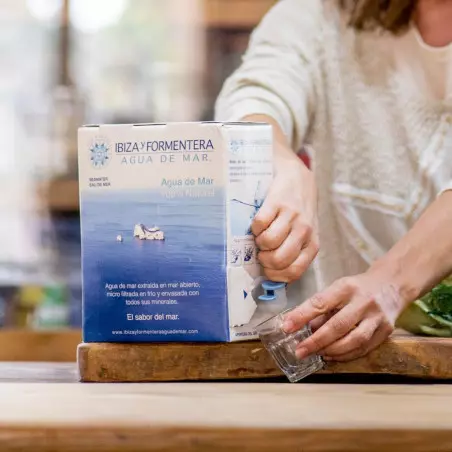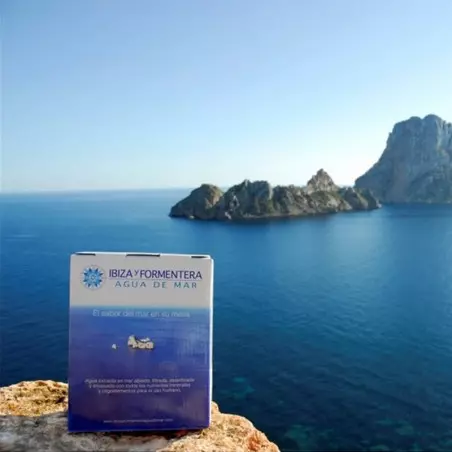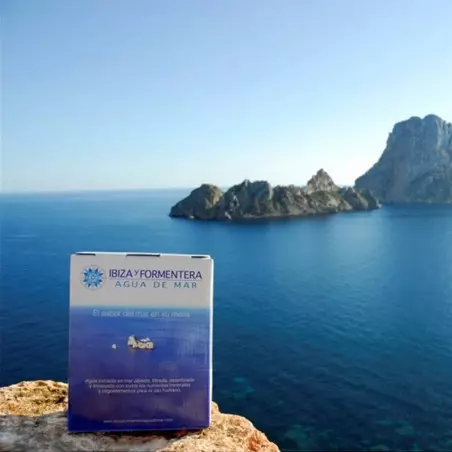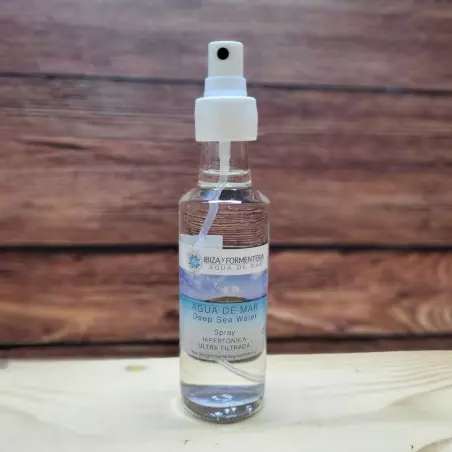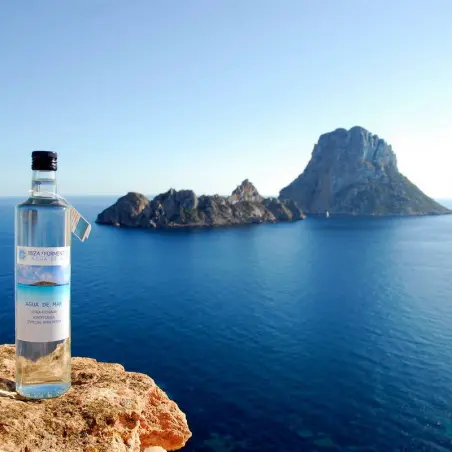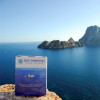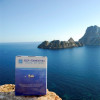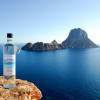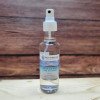The ocean, source of life and essential minerals
For millennia, humanity has recognized the intrinsic virtues of thesea water for well-being and vitality. Rich in a unique composition of mineral salts and Trace elements Essentially, seawater is perceived as a source of vital nutrients, capable of harmoniously resonating with the physiological needs of the body. This ancestral recognition underscores the importance of preserving and accessing marine water sources of impeccable quality.
It is in this spirit that the company Sea Water of IbizaIs committed, with a deep commitment to quality, sustainability, and respect for the natural environment.1 Originating from a family and eco-responsible approach, It honors maritime tradition while adopting modern practices to offer seawater of exceptional purity.. The collection is carried out in privileged areas, carefully selected for their distance from potential sources of contamination, thus ensuring a product of remarkable integrity.1
This article aims to explore in depth the scientific reasons that confer to the sea water of Ibiza a notable distinction. A rigorous comparative analysis with the waters of the Atlantic Ocean will be conducted, highlighting the unique natural processes and specific protection measures that contribute to the superior quality of the Mediterranean water of Ibiza. The goal is to provide an informed understanding, supported by scientific data, to guide choices regarding well-being and vitality.
The Ibiza Sanctuary: Posidonia Oceanica, Heart of Mediterranean Purity
What is Posidonia oceanica? An endemic and vital marine plant
The Posidonia oceanicaPosidonia Oceanic) is much more than just a marine plant; it is an endemic angiosperm, which means that it is Exclusively found in the Mediterranean and nowhere else in the world.3 Unlike the algae, Posidonia has a complex structure with roots, stems (rhizomes), and leaves, forming vast underwater meadows. These seagrass beds are ecosystems of unique complexity and ecological importance, acting as true lungs and natural filters for the Mediterranean basin.5
Ibiza and Formentera: Shelter of the largest living organism on the planet
The seabeds between the islands of Ibiza and Formentera are home to a natural treasure of unparalleled magnitude: the largest known living organisms on Earth. These are vast meadows of Posidonia oceanica, which can reach up to 15 kilometers wide, with an estimated mass of over 6,000 metric tons.4 What makes these grasslands even more extraordinary is their age, potentially over 100,000 years.3 This exceptional longevity is made possible by the ability of Posidonia to reproduce asexually, generating clones of itself that spread and persist for millennia.4
The survival and growth of a clonal organism of such size and age are compelling indicators of ecological stability and the exceptional quality of the water in this area. An ecosystem so ancient and vast could not thrive and endure for so long if it were subjected to significant levels of chemical pollution., plastic or radioactive, or to major ecological disturbances. The posidonia thus acts as a giant bio-indicator, reflecting the purity and intrinsic health of the surrounding water, far beyond what occasional analyses could reveal. Its vitality and resilience are a direct reflection of the preserved quality of its environment.
The exceptional ecosystem services of Posidonia: natural purifiers
The Posidonia oceanica meadows are not just simple marine habitats; they provide invaluable ecosystem services that directly contribute to the purity and vitality of the waters of Ibiza.
"Lung of the Mediterranean": Oxygen Production and Carbon Sequestration "Blue Carbon"
These seagrass beds are true "lungs" for the Mediterranean. As major primary producers, they release a large amount of oxygen into the water, significantly contributing to the oxygenation of the water column.6 Simultaneously, posidonia acts as a carbon dioxide sinkCO₂) of paramount importance, a role known as "Blue Carbon".5 These grasslands are capable of sequestering between 580 and 680 grams of CO₂ per square meter per year.5 Studies even suggest that they could potentially eliminate up to 42% of the carbon dioxide produced by Mediterranean countries.6 As being from "net autotrophs", they produce more oxygen than they consume, ensuring a marine environment rich in oxygen.7
This ability of the Posidonia to sequester such a significant portion of emissions CO₂ Mediterranean and oxygenating the water goes beyond a simple passive ecological role. It indicates an ecosystem that is actively working to maintain a remarkable chemical balance and water purity. Carbon sequestration helps buffer ocean acidification, a major environmental issue affecting water quality and marine life. Oxygen-rich water is inherently healthy water, promoting marine life and the natural degradation of certain pollutants. The posidonia acts as a large-scale "biological filtration system," actively purifying the water.
Natural filter and water purifier: Clarity and quality of water
Posidonia seagrass meadows actively contribute to the clarity and quality of the water. They are very effective at capturing and burying suspended particles in the water column, acting like a natural physical filter that improves water transparency.5 Beyond this physical filtration, the posidonia also functions as a "sink for nutrients and pollutants." 6, absorbing undesirable substances and helping to maintain a healthy nutritional balance in the ecosystem. This biological depollution action contributes to the purity of the water even before any industrial treatment.
Biodiversity hotspot and coastal protection
Posidonia is a true "hotspot" of biodiversity, home to hundreds of species and supporting complex food webs.5 These meadows serve as essential breeding and nursery areas for many marine species, including fish and invertebrates.6 Moreover, the accumulation of their dead leaves on the shoreline forms structures called "banquettes," which play a crucial role in protecting the coasts against marine erosion.5
The protection of a treasure: the Freus Marine Reserve and UNESCO status
The marine area located between Ibiza and Formentera is recognized as a major environmental protection site. It houses the Freus Marine Reserve, established in 1999 and whose boundaries were extended in 2015.9 This reserve is the second largest marine protected area in the Spanish Mediterranean, covering an impressive area of 13,617 marine hectares.9 The importance of this site is such that The Posidonia meadows found there have been classified as a UNESCO World Heritage Site since 1999., thus recognizing their outstanding universal value for biodiversity and marine ecology.1
Within this reserve, very strict regulations are enforced. Spearfishing, sport fishing, anchoring of boats, and diving without a permit are strictly prohibited in fully protected areas.9 These measures are explicitly aimed at protecting ecosystems, preventing their degradation, and promoting the recovery of endangered species.
The double status of "Marine Reserve"and of"UNESCO World Heritage"The Posidonia seagrass meadows in Ibiza and Formentera offer a top-tier environmental protection guarantee. This international recognition, combined with strict prohibitions (fishing, anchoring), is not merely symbolic. It involves active management, regular monitoring, and concerted efforts to minimize the direct anthropogenic impact on these waters.". This directly reduces the input of pollutants such as waste, fuels, and wastewater from boats, as well as the physical disturbances caused by anchoring. An undisturbed and actively protected marine ecosystem is inherently healthier and capable of maintaining purer water. This regulatory and active protection directly translates to better water quality at the source, offering a distinct advantage compared to less regulated areas.
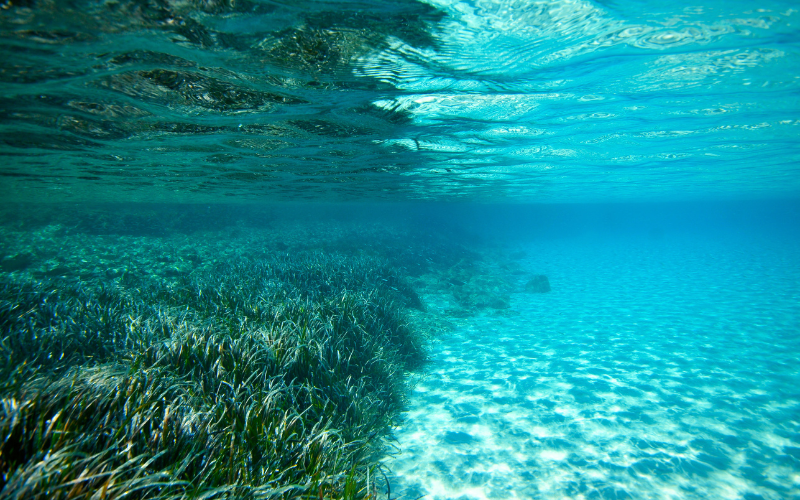
Comparative Analysis of Water Quality: Mediterranean (Ibiza) vs. Atlantic
To fully appreciate the quality of thesea water from Ibiza, a comparison with the waters of the Atlantic Ocean is essential, highlighting the challenges and strengths of each basin.
A. The Mediterranean: a monitored basin, preserved jewels
Context of plastic pollution in the Mediterranean: challenges and concentrations
Although the Mediterranean is generally affected by plastic pollution, the high concentration of microplastics and larger plastics, exacerbated by its semi-enclosed nature and coastal population density, underscores the imperative to select specific and protected sampling areas, rather than considering the Mediterranean as a homogeneous block. The data on plastic pollution, although concerning, specify that this pollution is often concentrated near land-based sources and in areas with low circulation. This nuance is crucial for the sea water of Ibiza, which is extracted from areas specially selected to be far from the coast and any possible source of contamination.1 It is therefore essential to distinguish the general pollution of the basin from specific and highly protected micro-environments.
The importance of Ibiza's seawater collection areas: far from sources of contamination
Sea Water of Ibiza places great importance on selecting preferred sampling sites, strategically distant from the coasts and any potential source of anthropogenic contamination.1 These specific areas ensure a high stability of the seawater composition, particularly in mineral salts and trace elements, and benefit from the presence of circular ocean currents called "vortex". These vortices play a crucial role in keeping the water perfectly clean and with a constant salinity.11 These currents also promote plankton blooms, benefiting from natural hyperoxygenation thanks to the surrounding seagrass meadows.11 The clarity of the water in Formentera, for example, can reach a visibility of 15 to 50 meters, a tangible sign of exceptional water quality.10
The combination of the rigorous selection of collection sites, natural purifying currents (vortex), and the action of posidonia meadows creates a micro-environment of exceptional purity for Ibiza's water. This synergy acts as a "natural filtration" even before the industrial process. Vortexes can help disperse pollutants and concentrate plankton, which is the foundation of a healthy and self-cleaning ecosystem. Meanwhile, Posidonia acts as a biological filter, a carbon sink, and a source of oxygen. This complex ecological interaction intrinsically contributes to superior water quality, going beyond the mere absence of pollutants, by creating a dynamic and healthy marine environment.
MARPOL Regulations: The Mediterranean as a "Special Area" for the prevention of marine pollution
The Mediterranean is designated as a "Special Area" by the MARPOL Convention (International Convention for the Prevention of Pollution from Ships) for several of its key annexes : Annex I (oil pollution), Annex II (noxious liquid substances), Annex IV (sewage from ships), and Annex V (garbage from ships).14 This designation implies a higher level of environmental protection than in ordinary maritime areas, with stricter discharge prohibitions (notably for oily waste, sewage, and garbage) and the requirement for ships to use advanced equipment.15 Furthermore, the ports in the region must provide adequate reception facilities for ship waste, thereby enhancing compliance.15
The "Special Area" MARPOL status for the Mediterranean, covering several types of pollution, indicates an international recognition of its vulnerability and a Stricter regulatory framework for marine protection compared to many areas of the Atlantic. This designation is concrete regulatory evidence of its need for increased protection and the measures put in place to achieve it. Although the full implementation of rules for wastewater and waste may be delayed due to the lack of adequate reception facilities in some ports 16, The regulatory intent is strong. This contrasts with the Atlantic, where such designations are more localized (for example, Emission Control Areas, ECA) or specific to certain annexes, but not as global for the entire basin concerning direct discharges of hydrocarbons, sewage, or waste. This gives the Mediterranean a significant regulatory advantage in terms of protecting water quality from ship-originated pollution.
B. The Atlantic Ocean: Specific Contamination Issues
The Atlantic Ocean, vast and dynamic, presents its own challenges in terms of water purity, distinct from those of the Mediterranean.
Plastic pollution in the Atlantic Ocean gyres
The Atlantic, like other oceans, contains vast accumulation zones of plastic, particularly within its subtropical gyres. In these regions, the concentrations of plastic debris can reach millions of pieces per square kilometer.13 Although concentrations in the open sea, outside of these gyres, are generally lower, the issue of plastic is pervasive on a global scale, with millimeter-sized fragments dominating the pollution.13
The issue of radioactive contamination: a more pronounced risk
The Atlantic is facing sources of radioactive contamination that are structurally absent from the seawater sampling areas in the Mediterranean, which gives it a more pronounced risk.
- The impact of the La Hague reprocessing plant (France) and its discharges
The nuclear fuel reprocessing plant at La Hague, located on the Cotentin Peninsula in France (Manche, part of the Atlantic basin), is a significant and continuous source of anthropogenic radionuclide discharges into the English Channel and the North Sea.17 Although the operator claims that the official annual dose for the local population is low (less than 20 microsieverts/year, equivalent to the cosmic radiation dose received during a transatlantic flight) 17, the factory intentionally releases radioactive materials into the ocean.17 Studies have shown that radionuclides such as cesium-137, iodine-129, strontium-90, cobalt-60, and plutonium isotopes are released and transported over long distances in the North Seas and the North Atlantic.18 It is crucial to note that sediments act as poor sinks for these substances, meaning they remain mobile in the water column, increasing their potential for dispersion and incorporation into the marine food chain.18
The presence of a continuous and significant source of anthropogenic radioactive discharges, such as the La Hague plant, represents a risk factor for contamination that is structurally absent from the seawater sampling areas in the Mediterranean. The fact that these radionuclides are only "weakly retained" by the sediments is a critical point, as it means they remain in solution or suspension, increasing their exposure to marine organisms and their potential for long-distance transport. Even though the direct risks to human consumption are considered low in the short term by authorities, the ongoing nature of these discharges and the mobility of contaminants raise questions about the long-term cumulative impact on the marine environment and the food chain.
- The sinking of the nuclear submarine K-8 in the Bay of Biscay
Another notable event is the sinking of the Soviet nuclear submarine K-8 in the Bay of Biscay (North Atlantic) on April 12, 1970.21 This submarine sank with its two nuclear reactors and four nuclear torpedoes on board, at a depth of 4,680 meters.21 The recovery of the wreck and its radioactive contents was deemed unfeasible due to the extreme depth.22
The sinking of the K-8 poses a potential source of long-term radioactive contamination in the deep Atlantic. Although the event is old and the depth may limit immediate dispersion, the presence of nuclear materials (reactors and torpedoes) signifies a potential source of radionuclide leakage over geological time scales. Even if the immediate risks to surface water consumption are low, it is a background contamination factor that adds to the overall radioactive load of the Atlantic, a type of risk not documented for extraction areas in the Mediterranean.
Comparison of MARPOL regulatory frameworks between the two basins
Although the Atlantic is subject to the MARPOL Convention (notably Annex VI for air pollution, with emission control areas like the North American ECA), 23, and Annex V for waste 24), it does not benefit from the global designation of "Special Area" for the entire basin for discharges of hydrocarbons, sewage, and waste, as is the case for the Mediterranean.14
The Mediterranean benefits from a stricter and more extensive MARPOL regulatory framework for protection against ship pollution (special areas for oil, sewage, waste) than the entire Atlantic. This difference in MARPOL status is crucial: the Mediterranean is a "Special Area" for multiple annexes, which means stricter discharge rules throughout the basin. The Atlantic has regulations, but the "Special Area" designations are more fragmented and targeted, for example, the emission control areas for North America. 23 or certain specific seas for waste.24 This suggests an inherently higher level of regulatory protection for the Mediterranean as a whole concerning ship pollution.
C. The micro-filtration process of Ibiza Sea Water: A safety guarantee
Beyond the natural advantages of its collection area, Sea Water of IbizaCommits to ensuring the purity of its water through rigorous purification processes. After sampling from areas selected for their natural purity, The water undergoes "several cold microfiltration processes" to eliminate any impurities or marine residues.1
Microfiltration is a highly effective physical method for removing microplastics and other particles from water.26 Advanced techniques can achieve up to 100% efficiency for microplastics.26 Although nanoplastics, due to their tiny size, are more difficult to filter, starting with naturally clean spring water significantly reduces the risk of their presence in the final product.27
The combination of a naturally pure source (thanks to the posidonia and the specific currents of Ibiza) and an advanced microfiltration process provides a double layer of security. This approach minimizes the risks associated with microplastics and other impurities, even those that would be difficult to remove through filtration alone. By reducing the initial load of contaminants at the source, the efficiency of subsequent treatments is maximized, ensuring high-quality and safe water for consumption.
The benefits of Ibiza's seawater for health and well-being
A unique and bioavailable mineral wealth
Thesea water is a natural matrix that contains all the elements of Mendeleev's periodic table, in an ionic and bioavailable form.11 These minerals and trace elements are essential for proper cellular function, acting as the main "fuel" for our body. They are indispensable for the absorption of vitamins and play a crucial role in enzymatic processes at the cellular level. 11 ,, but also in electrolyte balance and the transmission of signals in the nervous system. The mineral richness of seawater is not only quantitative; it is qualitative, with "bio-available" minerals.. This implies better absorption and utilization by the body compared to isolated or synthetic mineral supplements. Seawater can thus be considered a holistic nutritional supplement, providing a full spectrum of essential elements in an easily assimilable form.
The role of alkaline pH and antioxidant properties
Ibiza Sea Water Agua de Mar presents a Naturally alkaline pH, ranging between 8.1 and 8.4.11 This alkalinity can help the body maintain a neutral pH through the process of homeostasis. TheAlkalinity The minerals present in seawater also confer antioxidant and anti-acidity properties.11
The alkaline pH of the seawater in Ibiza, combined with its antioxidant power and natural oxygenation by posidonia, supports the "terrain" theory in health, as mentioned by Nobel Prize laureate Otto Warburg, who claimed that "all diseases are acidic and where there is oxygen and alkalinity, there can be no disease."11 The seawater of Ibiza aligns directly with this health philosophy, helping to create a bodily environment less conducive to imbalances, thus offering an advantage beyond mere hydration.
Support for cellular balance and homeostasis
The consumption of seawater, due to its complete and balanced mineral composition, helps to remineralize and rehydrate the body's cells, thereby supporting their vitality and ability to function optimally.11 It helps maintain electrolyte balance and homeostasis, fundamental processes for overall health.
Practical applications: from nutrition to daily hygiene
Beyond drinking, seawater offers multiple practical applications. In cooking, it can be used to enhance the flavor of foods without masking them, while providing minerals and trace elements in a healthy and natural way, making it an excellent alternative to saltordinary table.11 It integrates perfectly into vegan and plant-based recipes, where it enhances flavors while providing an additional nutritional dimension. Traditionally, Sea water is also used as toothpaste and mouthwash, as a nasal and eye decongestant, and for disinfecting small wounds and infections due to its antiseptic and healing properties.2
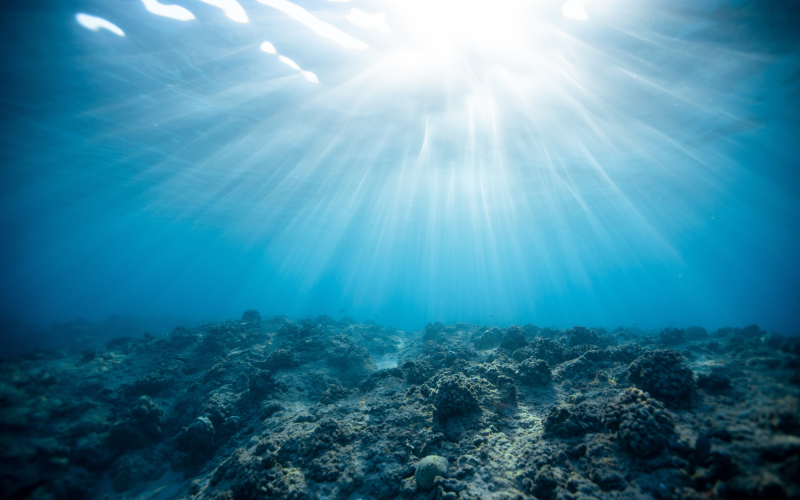
Conclusion: Choosing purity and natural vitality
The scientific analysis of the characteristics of the seawater of Ibiza reveals a source of purity and vitality that stands out distinctly from the waters of the Atlantic Ocean. This distinction is based on several converging factors: the unique source and protected by UNESCO meadows of Posidonia oceanica, which act as powerful natural purifiers and oxygen producers ;; the absence of major sources of radioactive contamination anthropogenic documented in its sampling areas; and a Stricter MARPOL regulatory framework for marine protection across the Atlantic.. These natural and regulatory elements, combined with a rigorous micro-filtration process implemented by Sea Water of Ibiza, guarantee an exceptional purity and mineral richness of the final product.
Make the choice to the sea water of Ibiza, it is to choose a natural resource whose quality is scientifically supported and whose extraction respects a unique and protected marine ecosystem. It is a commitment to personal well-being, drawing from a source of bioavailable minerals and vitality, while supporting an eco-responsible approach. The Biovie community is invited to discover the benefits of this seawater, a true treasure of the Mediterranean, for a healthy and balanced lifestyle.
Frequently Asked Questions (FAQ)
Q1: Is the seawater of Ibiza really purer than the water of the Atlantic Ocean ?
Response: Yes, scientific studies and unique environmental protections support this claim. The seawater collection areas of Ibiza are located in the Freus Marine Reserve, a UNESCO World Heritage site, home to the Posidonia oceanica meadows. These meadows act as natural filters and marine lungs, actively contributing to the purity and oxygenation of the water. Additionally, the Mediterranean benefits from stricter MARPOL regulations than the Atlantic for the prevention of ship pollution.
Q2: How does Posidonia oceanica contribute to the water quality of Ibiza ?
Response: Posidonia oceanica is a marine plant endemic to the Mediterranean and the largest living organism in the world, abundantly found between Ibiza and Formentera. It plays a crucial role in sequestering large amounts of carbon ("Blue Carbon"), producing oxygen, and filtering suspended particles and pollutants, thus contributing to the exceptional clarity and purity of the water.
Q3: Are there risks of radioactive contamination in the seawater of Ibiza or the Atlantic ?
Response: The seawater collection areas of Ibiza in the Mediterranean do not have major documented anthropogenic sources of radioactive contamination. In contrast, the Atlantic Ocean is exposed to sources such as the La Hague nuclear reprocessing plant in France, which releases radionuclides, and the site of the K-8 nuclear submarine wreck, posing a potential long-term risk.
Q4: How does Agua de Mar d'Ibiza ensure the removal of microplastics ?
Response: Agua de Mar d'Ibiza selects collection areas that are far from coastal contamination sources. Additionally, the water undergoes several advanced micro-filtration processes in the laboratory, a method recognized for its effectiveness in removing microplastics and other impurities, thus ensuring high-quality water for consumption.
Q5: What are the main health benefits of Ibiza sea water ?
Response: The seawater of Ibiza is naturally rich in all the minerals and trace elements of the periodic table in a bioavailable form, essential for cellular balance. Its alkaline pH (between 8.1 and 8.4) and antioxidant properties can help maintain the body's homeostasis and support a healthy internal environment, thus contributing to vitality and overall well-being.
Scientific references
- Arnaud-Haond, S., Duarte, C. M., Diaz-Almela, E., Marbà, N., Sintes, T., & Serrão, E. A. (2012). Implications of Extreme Life Span in Clonal Organisms: Millenary Clones in Meadows of the Threatened Seagrass Posidonia oceanica. PLoS ONE, 7(2), e30454. doi:10.1371/journal.pone.0030454
- Cozar, A., Echevarría, F., González-Gordillo, J. I., Irigoien, X., Úbeda, B., Hernández-León, S.,... & Duarte, C. M. (2015). Plastic debris in the open ocean. Proceedings of the National Academy of Sciences, 112(46), 14252-14257. doi:10.1073/pnas.1505495112
- Duarte, C. M., Kennedy, H., & Marbà, N. (2010). Seagrass meadows as a global carbon sink. Nature Geoscience, 3(10), 670-674. doi:10.1038/ngeo986
- Liubartseva, S., Coppini, G., Lecci, R., & Clementi, E. (2018). Modeling the transport and accumulation of marine litter in the Mediterranean Sea. Environmental Pollution, 237, 1088-1099. doi:10.1016/j.envpol.2017.11.083
- Morris, R. J. (1980). Floating plastic debris in the Mediterranean. Marine Pollution Bulletin, 11(5), 125. doi:10.1016/0025-326X(80)90099-2
- Pivokonsky, M., Kloucek, O., & Vacha, F. (2018). Occurrence of microplastics in drinking water and their removal during water treatment. Science of The Total Environment, 643, 1220-1227. doi:10.1016/j.scitotenv.2018.06.210
- Skipperud, L., Salbu, B., & Oughton, D. H. (2000). Radionuclide speciation in effluent from La Hague reprocessing plant in France. Journal of Environmental Radioactivity, 51(1), 1-14. doi:10.1016/S0265-931X(00)00041-8
- I'm sorry, but it seems like you've provided a reference or citation without any additional text to translate. Could you please provide the text you would like translated from French to English?. Radioactivité artificielle et naturelle dans la pollution environnementale et la radiochronologie. Springer. ISBN 1-4020-1860-6.
- UNEP/MAP. (2015). Marine Litter in the Mediterranean Sea: A Regional Assessment. UNEP/MAP, Athens.
- Van Sebille, E., England, M. H., & Froyland, G. (2015). Origin, dynamics and fate of ocean garbage patches. Environmental Research Letters, 10(9), 094006. doi:10.1088/1748-9326/10/9/094006
- WWF. (2018). Out of the Plastic Trap: Saving the Mediterranean from Plastic Pollution. WWF Mediterranean Marine Initiative, Rome.
Sources of the quotes
- Ibiza and Formentera Sea Water
- Ibiza and Formentera Sea Water - IBIZA PRODUCE
- Ilesbalears.travel
- La posidonie ancienne détient les secrets de l'organisme vivant le plus ancien sur Terre
- Posidonia Oceanica in the Mediterranean Sea: Threats and challenges for upcoming generations
- Posidonia oceanica Meadows as Carbon Sink in the Mediterranean Sea - Journal of Biomedical Research & Environmental Sciences
- Water column oxygenation by Posidonia oceanica seagrass meadows in coastal areas: A modeling approach - PubMed
- Cultural Ecosystem Services Provided by Coralligenous Assemblages and Posidonia oceanica in the Italian Seas - Frontiers
- Es Freus Marine Reserve | Formentera Tourism
- Els Freus Marine Reserve (Ibiza, Formentera) - Balearic Islands
- 0.75L marine plasma | Ibiza and Formentera Sea Water - BIOVIE
- Microplastics in the Mediterranean Sea: Sources, Pollution Intensity, Sea Health, and Regulatory Policies - Frontiers
- Accumulation of Plastic in the Mediterranean Sea - PMC - PubMed Central
- MARPOL | LR - Lloyd's Register
- What Are MARPOL Special Areas ? - Marine Insight
- Special Areas under MARPOL - Organisation Maritime Internationale
- The Hague site - Wikipedia
- Radionuclide speciation in effluent from the La Hague reprocessing plant in France - PubMed
- Average impact of the La Hague reprocessing plant in seawater... - ResearchGate
- Origin and age of an ongoing radioactive contamination of soils near La Hague reprocessing plant based on 239+240Pu/238Pu and 241Am/241Pu current ratios and 90Sr and Ln(III) soil contents - ResearchGate
- Soviet submarine K-8 - Wikipedia
- Bay of Biscay graveyard of nuclear-armed Russian submarine
- MARPOL Annex VI and the Act To Prevent Pollution From Ships (APPS)
- Prévention de la pollution par les ordures provenant des navires - Organisation Maritime Internationale
- Quarterly variability of floating plastic debris in the marine protected area of the Menorca Channel (Spain) | Request PDF - ResearchGate
- Recent Advances in Microplastics Removal from Water with Special Attention Given to Photocatalytic Degradation: Review of Scientific Research - MDPI
- Microplastics in drinking water - Organisation mondiale de la santé (OMS)



